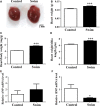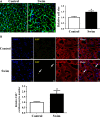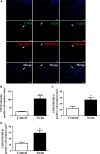Telocytes in exercise-induced cardiac growth
- PMID: 26987685
- PMCID: PMC4831349
- DOI: 10.1111/jcmm.12815
Telocytes in exercise-induced cardiac growth
Abstract
Exercise can induce physiological cardiac growth, which is featured by enlarged cardiomyocyte cell size and formation of new cardiomyocytes. Telocytes (TCs) are a recently identified distinct interstitial cell type, existing in many tissues and organs including heart. TCs have been shown to form a tandem with cardiac stem/progenitor cells in cardiac stem cell niches, participating in cardiac regeneration and repair. Although exercise-induced cardiac growth has been confirmed as an important way to promote cardiac regeneration and repair, the response of cardiac TCs to exercise is still unclear. In this study, 4 weeks of swimming training was used to induce robust healthy cardiac growth. Exercise can induce an increase in cardiomyocyte cell size and formation of new cardiomyocytes as determined by Wheat Germ Lectin and EdU staining respectively. TCs were identified by three immunofluorescence stainings including double labelling for CD34/vimentin, CD34/platelet-derived growth factor (PDGF) receptor-α and CD34/PDGF receptor-β. We found that cardiac TCs were significantly increased in exercised heart, suggesting that TCs might help control the activity of cardiac stem/progenitor cells, cardiomyocytes or endothelial cells. Adding cardiac TCs might help promote cardiac regeneration and renewal.
Keywords: CD34; PDGFR-α, β; exercise; heart; telocytes; vimentin.
© 2016 The Authors. Journal of Cellular and Molecular Medicine published by John Wiley & Sons Ltd and Foundation for Cellular and Molecular Medicine.
Figures



Similar articles
-
Cardiac telocytes are double positive for CD34/PDGFR-α.J Cell Mol Med. 2015 Aug;19(8):2036-42. doi: 10.1111/jcmm.12615. Epub 2015 Jun 17. J Cell Mol Med. 2015. PMID: 26082061 Free PMC article.
-
Cardiac Telocytes in Regeneration of Myocardium After Myocardial Infarction.Adv Exp Med Biol. 2016;913:229-239. doi: 10.1007/978-981-10-1061-3_15. Adv Exp Med Biol. 2016. PMID: 27796891
-
The Cutaneous Telocytes.Adv Exp Med Biol. 2016;913:303-323. doi: 10.1007/978-981-10-1061-3_20. Adv Exp Med Biol. 2016. PMID: 27796896 Review.
-
Hepatic Telocytes.Adv Exp Med Biol. 2016;913:425-432. doi: 10.1007/978-981-10-1061-3_27. Adv Exp Med Biol. 2016. PMID: 27796903 Review.
-
Immunophenotypic characterization of telocyte-like cells in pterygium.Mol Vis. 2018 Dec 29;24:853-866. eCollection 2018. Mol Vis. 2018. PMID: 30713424 Free PMC article.
Cited by
-
Morphological Evidence of Telocytes in Skeletal Muscle Interstitium of Exercised and Sedentary Rodents.Biomedicines. 2021 Jul 13;9(7):807. doi: 10.3390/biomedicines9070807. Biomedicines. 2021. PMID: 34356871 Free PMC article.
-
Modified mRNA-Mediated CCN5 Gene Transfer Ameliorates Cardiac Dysfunction and Fibrosis without Adverse Structural Remodeling.Int J Mol Sci. 2024 Jun 6;25(11):6262. doi: 10.3390/ijms25116262. Int J Mol Sci. 2024. PMID: 38892449 Free PMC article.
-
Identification and protective role of CD34+ stromal cells/telocytes in experimental autoimmune encephalomyelitis (EAE) mouse spleen.Histochem Cell Biol. 2023 Jul;160(1):11-25. doi: 10.1007/s00418-023-02186-5. Epub 2023 Apr 4. Histochem Cell Biol. 2023. PMID: 37014442
-
Telocytes and Their Extracellular Vesicles-Evidence and Hypotheses.Int J Mol Sci. 2016 Aug 12;17(8):1322. doi: 10.3390/ijms17081322. Int J Mol Sci. 2016. PMID: 27529228 Free PMC article. Review.
-
Telocytes: a potential defender in the spleen of Npc1 mutant mice.J Cell Mol Med. 2017 May;21(5):848-859. doi: 10.1111/jcmm.13024. Epub 2016 Nov 18. J Cell Mol Med. 2017. PMID: 27860245 Free PMC article.
References
-
- Bei Y, Zhou Q, Sun Q, et al Exercise as a platform for pharmacotherapy development in cardiac diseases. Curr Pharm Des. 2015; 21: 4409–16. - PubMed
Publication types
MeSH terms
Substances
LinkOut - more resources
Full Text Sources
Other Literature Sources
Miscellaneous

